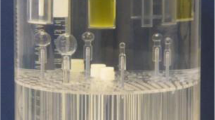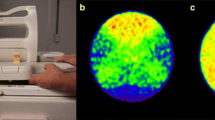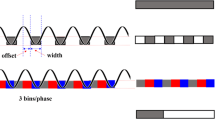Abstract
To assess the effect of lesion motion and respiration rate on Standardised Uptake Value (SUV) and the ability of 4D PET to restore any loss in SUV and distortion of lesion volume on two PET/CT systems. A Perspex phantom with four cylindrical reservoirs filled with 18F-FDG was used in this study. The cylinders measured 5, 10, 15, and 20 mm in diameter. A GE Discovery STE8 (GE Medical Systems Milwaukee, WI) and a Siemens Biograph 64/40 (Siemens Medical Solutions, Erlangen, Germany) scanner was used to acquire a stationary un-gated PET scan of the phantom. Multiple 10 min list mode 4D PET scans were acquired using the Varian RPM on the GE camera and the Anzai Gating system on the Siemens camera. The phantom was scanned at five different respiratory rates and motion amplitudes in a sinusoidal fashion, 15 RPM/1 cm, 15 RPM/2 cm, 15 RPM/4 cm, 30 RPM/2 cm and 7.5 RPM/2 cm (RPM-respirations per minute). Each scan was reconstructed into ten bins and as an un-gated static image. The SUVmax, SUVmean and volume were measured for all four reservoirs using Siemens TrueD analysis software. With increasing lesion movement the SUVmax and SUVmean decreased and the volume increased with the SUVmax in the smallest lesion underestimated by up to a factor of four. The SUVmax, SUVmean and volume were mostly recovered using 4D imaging regardless of amount of lesion displacement. The larger lesions showed better count recovery and volume correction than the smaller lesions. The respiratory rate had no effect of SUV or volume. Un-gated imaging of moving lesions decreases apparent SUV in small lesions significantly and overestimates volumes. 4D PET scanning recovers most of the apparent loss in SUV and distortion of volumes.






Similar content being viewed by others
References
Manus MPM (2010) Use of PET/CT for staging and radiation therapy planning in patients with non-small cell lung cancer. Q J Nucl Med Mol Imaging 54(5):510–520
Manus MM, Hicks RJ, Everitt S (2006) Role of PET-CT in the optimization of thoracic radiotherapy. J Thorac Oncol 1(1):81–84
Aristophanous M et al (2011) Clinical utility of 4D FDG-PET/CT scans in radiation treatment planning. Elsevier, Amsterdam
Lupi A et al (2009) The effect of 18F-FDG-PET/CT respiratory gating on detected metabolic activity in lung lesions. Ann Nucl Med 23(2):191–196
Nehmeh SA et al (2004) Four-dimensional (4D) PET/CT imaging of the thorax. Med Phys 31(12):3179–3186
Park SJ et al (2008) Evaluation of the combined effects of target size, respiratory motion and background activity on 3D and 4D PET/CT images. Phys Med Biol 53(13):3661–3679
Pevsner A et al (2005) Effect of motion on tracer activity determination in CT attenuation corrected PET images: a lung phantom study. Med Phys 32(7):2358–2362
Siva S, Manus MM, Ball D (2010) Stereotactic radiotherapy for pulmonary oligometastases: a systematic review. J Thorac Oncol 5(7):1091–1099
Ball D (2008) Stereotactic radiotherapy for nonsmall cell lung cancer. Curr Opin Pulm Med 14(4):297–302
Otani Y et al (2010) A comparison of the respiratory signals acquired by different respiratory monitoring systems used in respiratory gated radiotherapy. Med Phys 37(12):6178–6186
Seppenwoolde Y et al (2002) Precise and real-time measurement of 3D tumor motion in lung due to breathing and heartbeat, measured during radiotherapy. Int J Radiat Oncol Biol Phys 53(4):822–834
Bradley J et al (2004) Impact of FDG-PET on radiation therapy volume delineation in non-small-cell lung cancer. Int J Radiat Oncol Biol Phys 59(1):78–86
Erdi YE et al (2002) Radiotherapy treatment planning for patients with non-small cell lung cancer using positron emission tomography (PET). Radiother Oncol 62(1):51–60
Boellaard R et al (2010) FDG PET and PET/CT: EANM procedure guidelines for tumour PET imaging: version 1.0. Eur J Nucl Med Mol Imaging 37(1):181–200
van Herk M (2007) Different styles of image-guided radiotherapy. Semin Radiat Oncol 17(4):258–267
Webb S (2001) Concepts for shuttling multileaf collimators for intensity-modulated radiation therapy. Phys Med Biol 46(3):637–651
Author information
Authors and Affiliations
Corresponding author
Rights and permissions
About this article
Cite this article
Callahan, J., Binns, D., Dunn, L. et al. Motion effects on SUV and lesion volume in 3D and 4D PET scanning. Australas Phys Eng Sci Med 34, 489–495 (2011). https://doi.org/10.1007/s13246-011-0109-x
Received:
Accepted:
Published:
Issue Date:
DOI: https://doi.org/10.1007/s13246-011-0109-x




